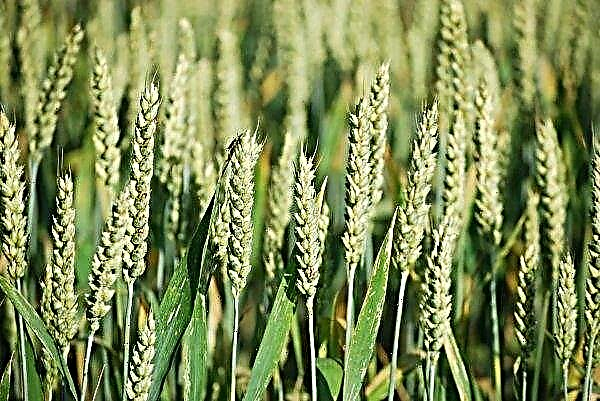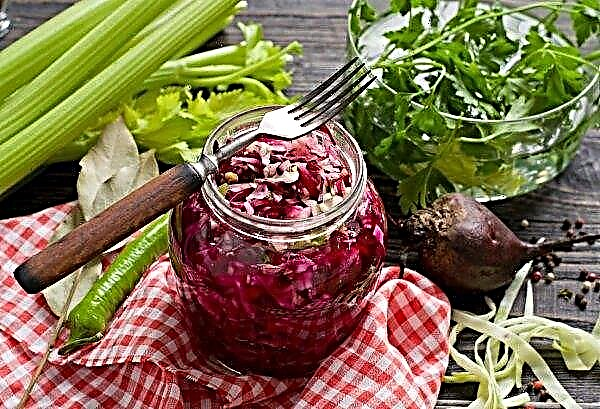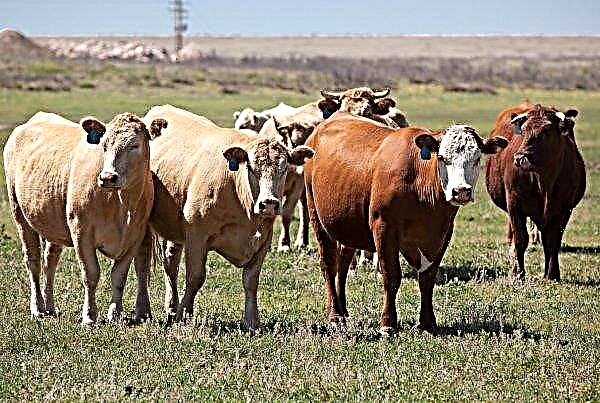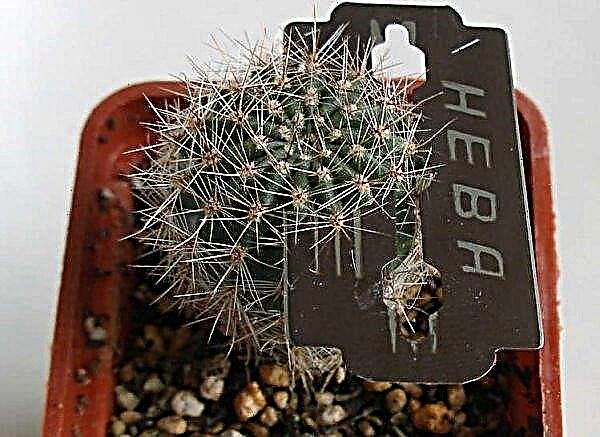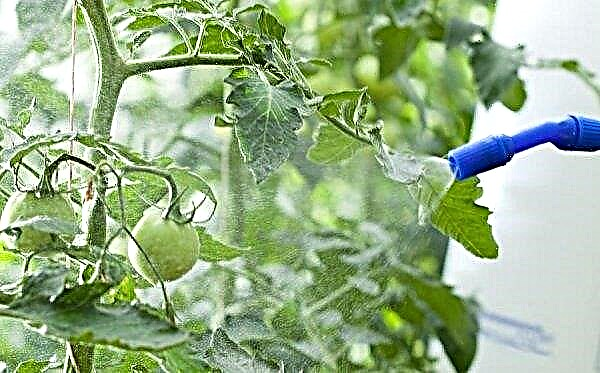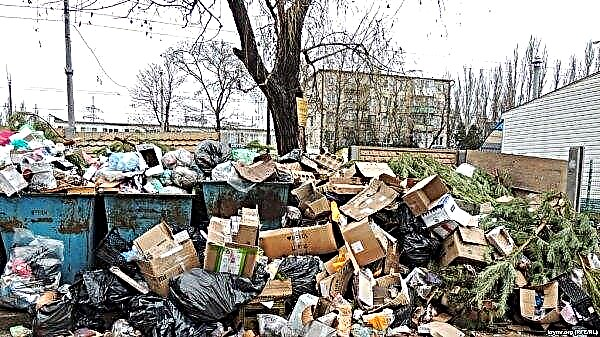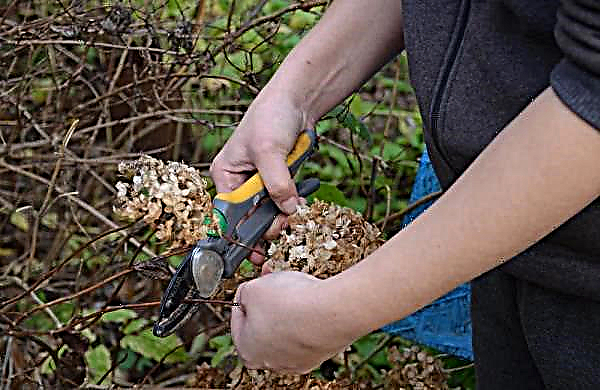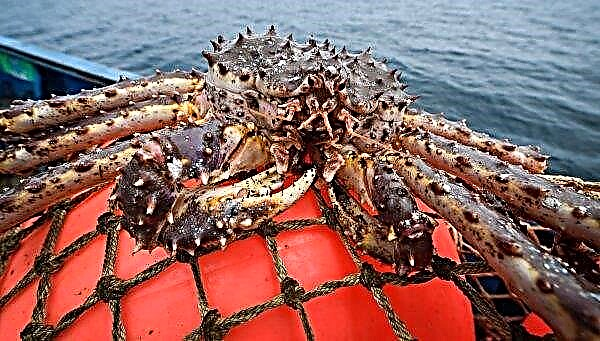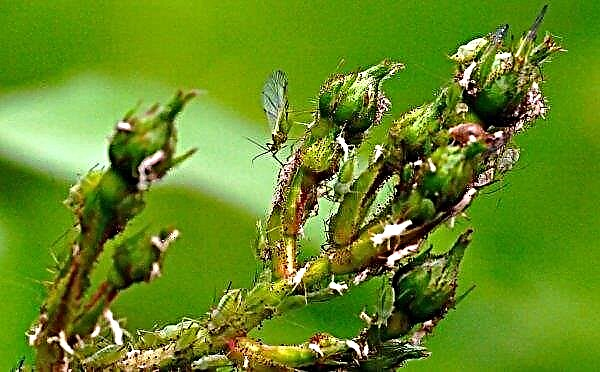A good crop of pepper can be obtained even from a small garden, provided that the right planting material and competent cultivation agricultural techniques are selected. A hybrid variety Chanterelle F1 is suitable for this, which is distinguished by its early ripening of small fruits, average yield and high resistance to common diseases. Learn about the features of growing a hybrid, as well as its advantages and disadvantages, further from the article.
Variety selection and characterization
The compactness of the undersized bush, the meatiness and juiciness of small fruits, which have almost no seeds, are the main characteristics of the hybrid. Its authors, breeders of the Siberian branch of the Federal State Budget Scientific Institution “Federal Research Center of the Institute of Cytology and Genetics of the Siberian Branch of the Russian Academy of Sciences”, in the process of crossing, sought to obtain a determinant variety of sweet pepper with satisfactory yield and endurance to growing conditions, as well as with high taste indices and keeping fruit. At the same time, scientists focused on the taste characteristics of the fruit, missing their size.
Did you know? In ancient times, pepper could not only pay for goods, but also pay fines. Prosperous merchants were then called “bags of pepper”, which emphasized the status and stable income..
The pepper bush develops up to 35 cm in height and is characterized by a conical shape. Under favorable conditions, its crop matures in 130-135 days from planting. These are fragrant bright orange glossy fruits weighing about 40 g with fleshy walls up to 7 mm thick. They taste sweet, juicy and crispy. Recommended for whole-canned preserves for the winter. But fresh vegetables can be stored for a long time in a cool room or refrigerator.
Video: Chanterelle Chanterelle F1
The variety is suitable for cultivation in the seedling method in open ground and greenhouses. From the place of growing Chanterelle depends on its productivity. On average, no more than 1.5 kg of vegetables can be removed from each plant. Subject to the recommended distance between seedlings, the yield of 1 m² is 3–3.5 kg.
Advantages and disadvantages
- Judging by the reviews of gardeners, the merits of sweet pepper Chanterelle F1 can be considered:
- high taste;
- saturated bright color of fruits;
- precocity
- compactness and stunting of the bush;
- satisfactory harvest quality;
- hybrid resistance to traditional diseases;
- the ability to grow crops even in flower pots;
- a small amount of seeds inside the fruit.

- Among the disadvantages:
- small sizes of pepper;
- low seed germination (up to 33%);
- insignificant distribution of the variety, which complicates the search for quality seed.
Growing seedlings at home
The quality of home seedlings is affected by the timing of planting grains, because overgrown stems will grow from early crops, and weak and unadapted to replanting from later crops. Also important is the care of the emerged seedlings.
The timing
The cultivation of chanterelle pepper F1 is not much different from other varieties. If you are preparing seedlings for the greenhouse, it is better to plan the sowing of seeds at the end of February, and for open beds these activities can be held in early March.
Did you know? The birthplace of all types of pepper is India. But in the modern producer market, Vietnam has been replaced by Vietnam in terms of the number of fruits grown for export.
Soil selection and preparation
Vegetable grows well in nutritious loose soil with neutral acidity.
To prepare such a light mixture you will need:
- garden chernozem substrate (1 h);
- river sand (1 hour);
- vermiculite (1/3 h.);
- high peat (2 hours);
- humus or compost (2 hours).
All components are thoroughly mixed, after which 1 tablespoon of wood ash is added to each kilogram of the prepared substrate. Then the soil is disinfected with a weak solution of potassium permanganate or roasted in the oven.

Capacity selection
The roots of any kind of sweet pepper are very sensitive to mechanical damage. If root growth is affected during transplantation or during loosening of the soil, the plant is restored for a long time, which inhibits its development. Therefore, it is advisable to sow this hybrid in separate containers, but for lack of such, you can use any container.
Did you know? Peppers are popularly called the “beauty vegetable”: fruits improve the condition of hair, skin, nails. That is why they can be found in the list of components of cleansing and tonic cosmetic products.
For growing seedlings, gardeners can use:
- Peat pots. Made from a porous material, aeration of the roots of the plant is promoted, which is useful for its growth. Such products are filled with slightly moistened soil and seeds are planted in it. The grown seedlings do not dive, but are transplanted to a permanent place along with the tank. Advantages of this choice: environmental friendliness and nutritional value of the material, as well as a high percentage of survival of seedlings during transplantation. Excessive sensitivity of the peat pot to moisture can be considered a disadvantage - if the crops are overfilled, the walls of the tank will be covered with mold and infect the soil. In this case, the drying out of the soil is unacceptable, otherwise it will be petrified.
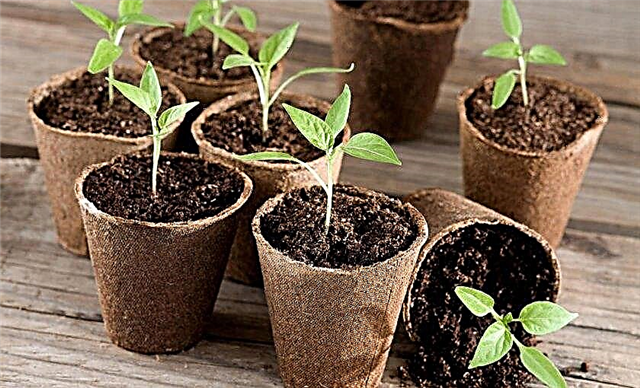
- Peat pills. They are compact fine peat with the addition of micronutrients, wrapped on the outside with a thin, durable mesh. There are different diameters: from 2.5 to 4.5 cm. Due to the tendency to swell, they are placed in a tray or in separate plastic cups, watered and, waiting for an increase in size by 5-6 times, they plant seeds. The advantages of tablets are the water and air permeability of the nutrient material, as well as the unhindered development of the root system. A flaw is the need to constantly monitor the moisture level in the crops.
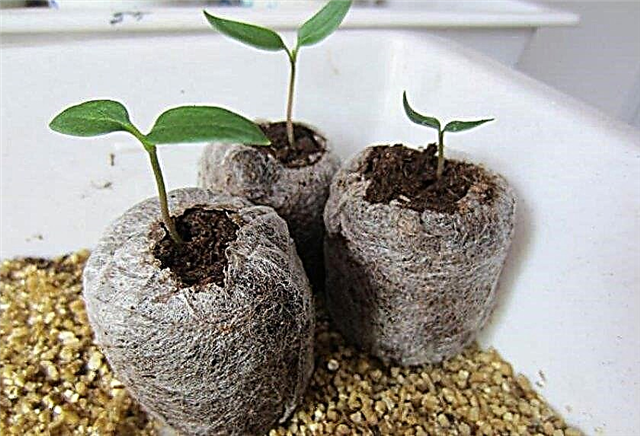
- Peat Cassettes. This planting capacity is similar to an egg tray of 70% peat and 30% cardboard. The grown seedlings are transplanted with the cell, separating it from the general section and completely deepening into the ground, otherwise it will cause dehydration of the roots of the seedling. The advantages of such containers are the additional nutrition that the culture receives when the material is dissolved, as well as the safety of the roots during transplantation. Minus - a tendency to quickly get wet and moldy.

- Polystyrene and polyvinyl chloride cassettes. The advantages of these portable nurseries are their availability, durability, lightness and compactness. In addition, the perforated base of the tank provides seedlings with an optimal water-air regime. Growing roots are laid in the form of a spiral and are not injured during transplantation, since they are easily untwisted. Plants grown in cassettes are always easy to take root. Polystyrene products are beneficial in the absence of toxic substances, but the chlorine present in PVC is dangerous for human health.
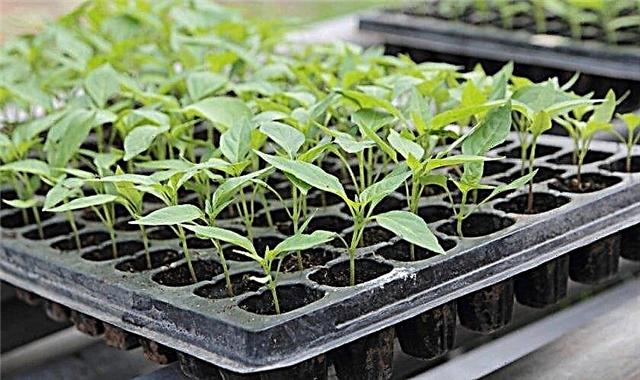
- Homemade wooden and plastic boxes. Their advantage can be considered a variety of structural sizes and material safety. Among the shortcomings are the need to dive seedlings and the risks of damage to the roots during transplantation, because in the total capacity fragile sprouts are often confused.

- Nursery nurseries. These are all kinds of food containers from purchased products found in every kitchen. Their advantage is transparency, which allows you to control the condition of crops, as well as a cover that provides a greenhouse effect. Cons are small in size and the difficulty of extracting seedlings during transplantation.

Seed selection and preparation
Seeds of two years ago are suitable for sowing - in contrast to annual seeds, they are characterized by high germination and short germination times. This is important to consider when preparing home planting material.
Of the purchased grains, zoned samples that are well adapted to the climate of a particular area are preferred. When buying seeds, experts advise paying attention to quality holograms and trust only trusted suppliers. Do not ignore modern agricultural achievements in this area. To improve the germination and preservation of grains in the soil, many manufacturers resort to pelleting, inlay, gel shell, tape, plasma structures. All these innovations are, to one degree or another, aimed at stimulating the viability of planting material and its resistance to various diseases.
Before sowing, home seeds should be disinfected in a weak solution of potassium permanganate, and then rinse and soak for 5 hours in water heated to + 50 ° C. Subsequently, the swollen grains are wrapped with a damp cloth and germinated for 2-3 days at a temperature of + 20 ° С. To accelerate the emergence of seedlings, it is recommended to add any growth stimulant to the cooled liquid (Emistim, Ecosil, Kornevin).Important! For growing sweet pepper seedlings in individual containers, containers with a diameter of about 8 are preferred–10 cm. Large pots are inappropriate due to the slow growth of the crop.

Sowing seeds
If planting containers are individual containers, sweet pepper seeds are sown in a moist substrate. Initially, they are filled with pots and moistened with a spray bottle. At this stage, it is advisable to use melt water, because a short-term cold will contribute to the development of vitality - thanks to this, the seedlings will grow strong and resistant to diseases. You can water the soil by covering it with snow, but this technology is acceptable only for ungrown seeds. If you plant grains with sprouts, the temperature of the earth should correspond to the range +25 ... + 27 ° С.
When sowing the culture in common containers, it is important to maintain a distance between grains of 8-10 cm. It is better to plant in cassettes, distributing 1 seed per cell. The grains are deepened by 1.5 cm and covered with a layer of moist soil with a thickness of 0.5 cm. Then, the seeding is slightly compacted with palms and mulched to preserve moisture.
At the final stage, the landing container is wrapped in polyethylene or covered with glass and placed in a warm and dark place. After emergence, the container must be moved to the light.
Important! So that the plants planted in the cassettes do not obscure each other, it is necessary to sow in a checkerboard pattern.
Seedling Care
The quality and quantity of the sweet pepper crop is equally dependent on the care of the emerged seedlings.
For full development from the first days they need to provide:
- Temperature mode. Initially, after removing the film, the container is put in a cool room for a week. At daytime temperature +16 ... + 17 ° С and nighttime +13 ... + 14 ° С root processes will begin to develop intensively. Then the tank must be transferred to heat, where during the day the level is maintained at +25 ... + 27 ° С, and at night - +13 ... + 14 ° С. It is important to pay attention to the difference in permissible day and night values - they are needed to simulate natural conditions and harden seedlings.
- Regular moderate watering. It is carried out to the extent necessary, avoiding either drying out or bogging of an earthen coma. All moisturizing procedures are best done using a spray gun, which will prevent the grains from leaching from the ground and exposing the roots of the emerged sprouts. Preferred rainwater, or settled for 24 hours. It is important that it warms up to + 30 ° C. Otherwise, the stems will be frail and fragile.

- Good lighting. In the case of pepper, phytolamps will come to the aid of the gardener with 12-hour work - otherwise the seedlings will stretch. The device should highlight the culture at a distance of half a meter, from about 7 a.m. to 7 p.m.
- Nutrients in the soil. If you notice a growth lag, seedlings will need additional nutrition. In containers that do not provide for picking, they are carried out one week after emergence, and in other cases 12 days after the picking. Initially, phosphorus fertilizers are useful for Chanterelle, which stimulate the development of rhizomes (a solution of "Crystal Yellow" in a proportion of 30 g per 10 liters of water). Subsequent feeding is carried out after 7-10 days with drugs that stimulate vegetation (Crystal Special, 30 g per 10 liters of water).
- Timely picking when growing seedlings in a common box. The procedure is relevant when the plant enters the cotyledon phase. This is evidenced by the formed first pair of leaves. Plants are planted neatly, protecting the roots from damage. To do this, you first need to moisten the substrate well and after it gets wet, move the sprout together with the earthen lump into a separate container.
Important! It is useful to mulch pepper with rotted straw. A layer with a thickness of 10 cm will reduce the frequency of irrigation to once every 9-10 days.
Seedling hardening
A sharp temperature difference when transplanting seedlings from room conditions into a greenhouse or an open bed adversely affects the condition of plants. Stressful changes in growing conditions contribute to sensitivity to the pathogenic environment. This is due, including damage to the root processes and inhibition of metabolic processes.
The adaptation period can be reduced by hardening seedlings, which consists in a smooth change in the usual temperature and moisture modes.
You can begin hardening a month after the emergence of seedlings. To do this, in calm, sunny weather, seedlings are exposed to fresh air. It can be an open balcony or a garden area protected from direct sunlight. Initially, a 15-minute stay in a new environment is enough for young seedlings, and later on this period is gradually increased to a maximum. It is important to take the plants to the usual conditions at night.

Planting seedlings in a permanent place
Ultra-early fruiting of sweet pepper is possible with greenhouse cultivation. This makes sense when, due to the climatic characteristics of a particular region, summer is cold. Also, the Chanterelle variety gives a good harvest outside of shelters.
The timing
Transplanting vegetable seedlings to a permanent place is planned approximately 2 months after sowing seeds. Under shelter, plants can be planted in the first ten days of May, and on an open bed in late spring, when the risks of frost are passed and the weather is stable and stable. The main thing is that the earth warms up to + 12 ° С, and the daytime temperature should not be lower than + 15 ° С.
Important! When fertilizing the beds in order to disinfect the manure before putting it into the soil, pour it with a solution of copper sulfate, which is prepared in a ratio of 5 g per 10 liters of water.
Seat selection and crop rotation
For pepper in the garden, a well-lit fertile area is ideal, where cold air does not settle, there are no through northern winds, and groundwater is located no closer than 1.5 m to the surface of the earth. Southern chernozem zones with a slight slope are preferred.
Sweet pepper is not recommended to be planted after tomatoes, eggplant and potatoes. Also, culture can not be planted in the same place for 3 years, because this is fraught with depletion of the soil and inhibition of the growth of new seedlings.
Good precursors for the hybrid are:
- zucchini;
- pumpkin;
- cucumbers
- gourds;
- all kinds of cabbage;
- legumes;
- perennial herbs.

Regardless of the location of cultivation of the hybrid, preliminary preparation of the landing site is required.In the fall, polycarbonate structures are fumigated with sulfur blocks for disinfection (based on 300 g of substance per 5–10 m³ volume). Please note that the sulfur dioxide contained inside has a detrimental effect on human health. Therefore, disinfection must be carried out scrupulously, but quickly. 36 hours later, the plant residues of the precursors are removed in the greenhouse and treated with a solution of copper sulfate (0.05%) all internal and external surfaces, as well as inventory.
Mineral and organic fertilizers are added to the soil, based on the soil composition of the greenhouse:
- loamy and clayy substrates require the introduction of a bucket of manure, river sand, 2 buckets of peat and half a bucket of sawdust per square meter of area;
- add a bucket of sod substrate, river sand and humus to the peat plot;
- sandy soil is fed with a mixture of clay, peat, humus and sawdust in a ratio of 3: 2: 2: 1.
- in any area, the nutritional composition of 2 glasses of wood ash, 15 g of urea, 30 g of superphosphate and 45 g of potassium sulfate will not be superfluous.
Important! For the quick adaptation of pepper, it is recommended to transplant seedlings in the afternoon or in cloudy weather. Such conditions will allow the roots to grow stronger before the onset of heat.
If you plan to grow pepper in the open ground, in October you need to fertilize the bed with a mixture of nitrogen-containing substances (for each square meter you will need 4 parts of the finished mixture):
- superphosphate (80 g);
- wood ash (1 kg);
- compost (1 kg);
- peat (2 kg).
Scheme and depth of landing
Before transplanting seedlings, the selected area is cleaned of weeds and loosened, grown stems are abundantly watered. When the earthen lump is completely saturated with moisture, it is passed along with the sprout into a made wet hole. It is important to maintain a distance of 40–45 cm between neighboring vegetables and 50–60 cm between rows. The depth of the furrows should correspond to the size of the root system of plants (about 5–8 cm). Under the new conditions, seedlings should be placed a little deeper than the previous level.

Care Tips
Peppers take root much worse compared to other vegetable crops, so they need to be watered more often, as well as to monitor the dynamics of the tops and the condition of the soil in which the crop grows.
Watering
For the full development of sweet pepper, you need to water the garden twice a week. Under each root, it is advisable to pour 1.5–2 liters of warm, settled water. In hot weather, as well as during harvesting, moisturizing is carried out daily, preventing waterlogging and drying out of an earthen coma.
Many vegetable growers have replaced manual irrigation with mechanical and automated structures. Especially popular are drip installations, which allow you to control the level of humidity in the greenhouse and garden without the expense of physical resources.
Soil care
After each watering, the soil must be loosened, thereby preventing the formation of a hardened crust. In proportion to the appearance of weeds, the relevance of weeding the bed increases. Such neighbors are extremely undesirable, since they suppress the vegetable crop in growth, draining the soil, and attract pests.
During the period of active growth, the plant needs to be earthed. This is done carefully, because the roots of solanaceous crops painfully tolerate any damage and take a long time to recover.
The bed is mulched with a layer of overripe straw, about 10 cm thick. This is done in order to prevent evaporation of soil moisture and the growth of weeds.
Important! Directly before planting seedlings, you can not make fresh manure.
Top dressing
2 weeks after transplanting seedlings, when the adaptation period ends, nutrients can be added to the soil. During the season, the culture is fed with fertilizers no more than 4 times with an interval of 12-14 days. It is important to alternate mineral and organic fertilizers, as well as monitor the development of the plant.
For the first time, a solution of:
- ammonium nitrate (5 g);
- superphosphate (0.3 g);
- potassium chloride (1 g).
Subsequent feeding involves doubling the proportions used.
If the foliage of pepper began to curl, and a dry border appeared on its edges - there is not enough potassium in the soil. This component requires special care, because with its excess, the culture withers.
Deficiency of nitrogen-containing substances is evident from the matte surface of the leaves, as well as their fading and grayish tint.
Phosphorus is required when the inside of the leaf blades turns purple.
With a lack of magnesium, the foliage becomes marble.
Did you know? Chocolate and bell peppers have common properties. Both of them “release” endorphins, the so-called “hormones of happiness,” into the blood.
Garter and bush formation
In order for the fragile shoots not to break during the fruiting period under the weight of the crop, the bush can be tied to a support. But in the case of the variety Chanterelle F1, there is no need for this procedure, since the plant stops growth, reaching a height of 35 cm, and on its branches no more than 12 fruits are formed, whose weight does not exceed 40 g.
For this hybrid, stepsoning and bush formation are relevant. In hot and damp weather, you must definitely remove the lower stepsons and foliage. This will improve the ventilation of the beds, as well as prevent bacterial and fungal diseases. In the heat of the bush is better not to touch, because its branches will protect the soil from evaporation of moisture.
To increase productivity, experienced gardeners advise pinching the main sprout from the first branch.
During the period of active growth on the bushes of sweet pepper, the longest branches are shortened, with the aim of their uniform illumination. The entire lateral shoot below the main branch on the stem, as well as inside the crown, is subject to liquidation. Pruning is recommended every 10 days and after harvesting.
Sweet pepper Chanterelle F1, despite the modest size of the fruit, is distinguished by their high taste. The variety is beneficial for its versatility, as it is suitable for open ground, greenhouse and even indoor cultivation. The undoubted advantage of the hybrid is the possibility of long-term storage in fresh form.







